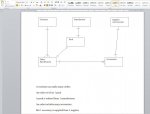Hi,
I just need to clarify something and need someone to explain it as detailed and as easy as possible.
I have a 4 tables:
Customer
Order
Accessories
Suppliers
Now I have
PK ID in Customer table
PK ID in Order table
PK ID in Accessories table
PK ID in Suppliers table
But I also have
FK customerID in Order table
FK AccessoriesID in Order table
FK SupplierID in Accessories table
When I join up. I have 1-many realtionships. eg. ID to customerID from Customer table to Order table.
How do I create a 1-1 relationship?
I thought my Suppliers table to Accessories would be this.
eg. an accessorie only has 1 supplier BUT a supplier can be used once on multiple accessories.
What do I link to relationship wise to get 1-1? Is 1-1 really possible when Suppliers table could be a lookup table of a combo box for example?
I'm stumped and I should know this.
Cheers
I just need to clarify something and need someone to explain it as detailed and as easy as possible.
I have a 4 tables:
Customer
Order
Accessories
Suppliers
Now I have
PK ID in Customer table
PK ID in Order table
PK ID in Accessories table
PK ID in Suppliers table
But I also have
FK customerID in Order table
FK AccessoriesID in Order table
FK SupplierID in Accessories table
When I join up. I have 1-many realtionships. eg. ID to customerID from Customer table to Order table.
How do I create a 1-1 relationship?
I thought my Suppliers table to Accessories would be this.
eg. an accessorie only has 1 supplier BUT a supplier can be used once on multiple accessories.
What do I link to relationship wise to get 1-1? Is 1-1 really possible when Suppliers table could be a lookup table of a combo box for example?
I'm stumped and I should know this.
Cheers

